I’ll never forget my first time walking through a busy airport runway as part of an aviation safety audit. I was struck not just by the planes flying overhead but by the sheer number of signs, markings, and lights scattered across the airport.
It wasn’t until I got closer that I realized how critical these airport signs and markings are to the safety of both aircraft and ground crew. These symbols and signs might seem mundane at first glance, but they’re lifesaving, literally.
From runway markings to taxiway signs, every aspect of airport signs and markings is carefully designed to ensure safety and smooth operations.
As someone who’s spent over 20 years in aviation safety, I’ve come to appreciate how vital these little details are to the overall safety of air travel.
Understanding what these signs mean can make a significant difference, whether you’re a pilot, a ground crew member, or simply a frequent flyer seeking to comprehend the essential elements of airport safety.
Let’s take a closer look at the importance of airport signs and markings, what they signify, and how they contribute to maintaining safety at airports worldwide.
Why Are Airport Signs and Markings So Important?
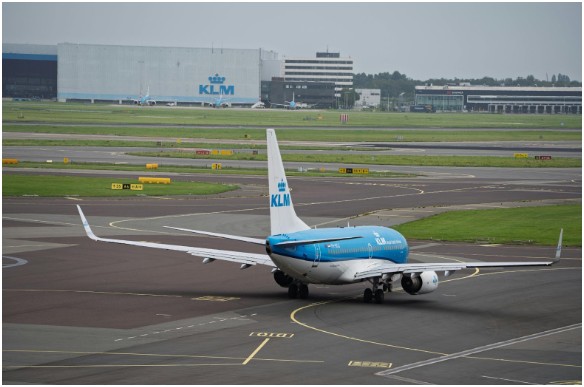
How Do Airport Signs and Markings Contribute to Safety?
Imagine a busy airport during rush hour. Planes are taking off, landing, and taxiing, all while ground crews direct aircraft, prepare them for takeoff, or guide them to gates.
With so much activity happening simultaneously, the need for clear communication and direction is paramount. This is where airport signs and markings play a crucial role.
These signs serve several functions, from guiding pilots along taxiways to ensuring the safety of ground crews.
They help aircraft navigate from one part of the airport to another and alert personnel to hazards, runway crossings, or no-go zones. It’s not just about keeping things organized—it’s about keeping things safe.
Every symbol or marking on the ground or in the sky is carefully chosen to provide the right information at the right time.
For example, hold short lines indicate where an aircraft must stop before entering a runway, ensuring that planes don’t enter an active takeoff zone by mistake.
Runway markings provide critical data for pilots, helping them understand the available runway length and orientation.
Can Airport Signs and Markings Prevent Accidents?
Absolutely. While airport signs and markings may seem like background elements, they can prevent accidents by ensuring that every step, whether it’s a pilot’s decision or a ground crew’s action, is informed by clear, standardized information.
A runway incursion, where an aircraft mistakenly enters an active runway, can be prevented by clear signs and markings. Similarly, taxiway signs ensure that aircraft follow safe paths to avoid collisions or other hazards.
Types of Airport Signs and Markings
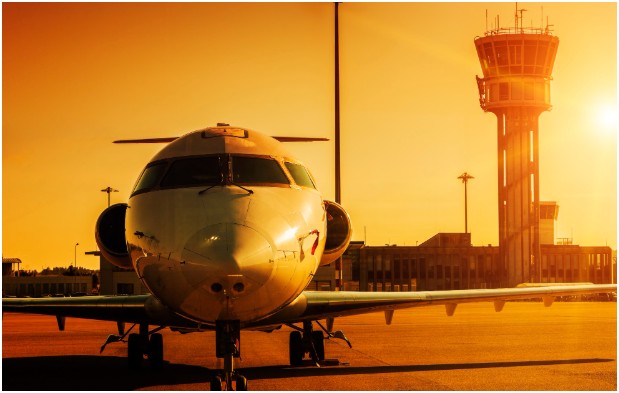
What Are the Different Categories of Airport Signs and Markings?
Airport signs and markings can be categorized into several groups, depending on their location, purpose, and the information they provide.
Understanding each of these categories is crucial to navigating an airport safely and efficiently. Here’s a breakdown of the most important categories:
1. Runway and Taxiway Markings
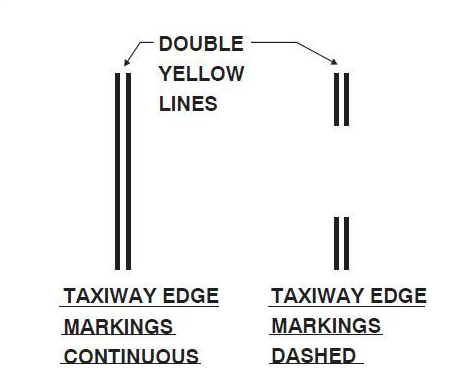
Image source- www.faa.gov
Runway and taxiway markings are the most important visual cues for pilots. These markings provide information about the airport layout, runway length, and the direction in which the aircraft should proceed. Let’s break down some of the key runway and taxiway markings:
- Runway Centerline: A continuous white line that helps pilots align the aircraft during takeoff and landing.
- Threshold Markings: These indicate the start of a runway suitable for landing. They consist of a series of wide white stripes across the runway.
- Taxiway Centerline: A solid yellow line that guides aircraft to the correct taxiway.
- Holding Position: A double solid yellow line indicates where aircraft must stop and wait before proceeding onto a runway.
2. Directional Signs
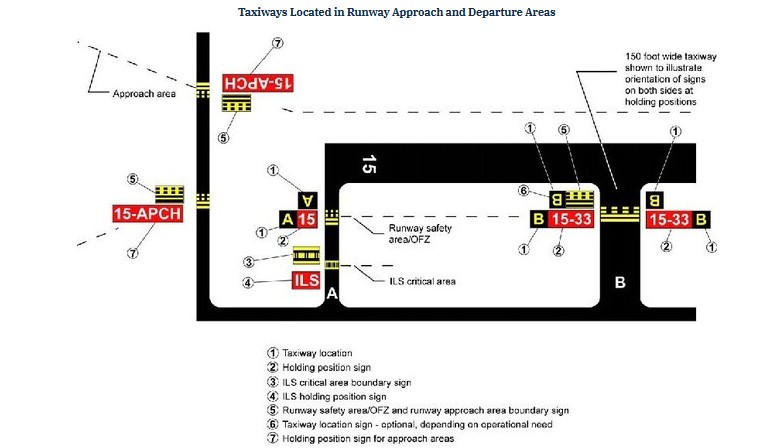
These signs guide pilots and ground crews to the correct locations on the airport’s expansive layout. Directional signs are color-coded and feature arrows that indicate which way to go:
- Taxiway Signs: These signs display yellow letters on a black background, helping pilots understand which taxiway they are currently on or heading toward.
- Runway Exit Signs: These green signs indicate which exit runway to take, helping pilots avoid taxiing too far.
3. Safety Signs
Safety signs are there to inform and warn personnel of any hazards or specific safety procedures to follow. They come in a variety of shapes and colors to alert workers and pilots about potential dangers:
- Warning Signs: These are typically yellow with black lettering, signaling hazards such as bird activity or runway incursions.
- Mandatory Instruction Signs: These signs have red backgrounds and indicate actions that must be followed, such as “STOP” or “DO NOT ENTER”.
4. Information Signs
These signs provide general information to pilots, ground crew, and even passengers. They include important operational information, such as weather conditions, runway availability, and airport facilities:
- Altitude and Clearance Information: These signs, typically black with white or green text, provide specific instructions about altitudes, minimum landing distances, or other critical data.
How to Make the Most of Airport Signs and Markings
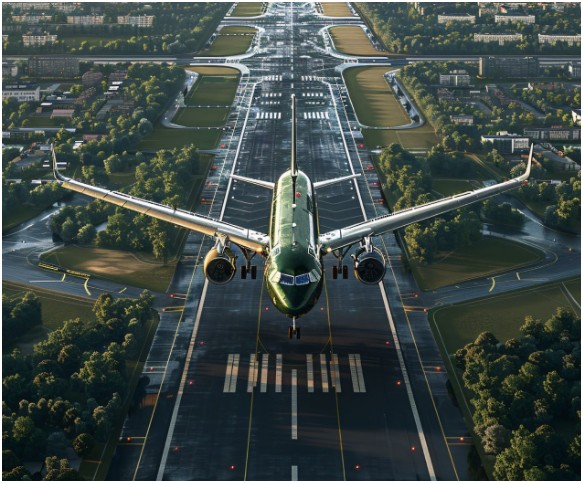
How Can You Maximize Your Safety and Efficiency with Airport Signs?
Understanding airport signs and markings is essential to ensuring safety and minimizing delays. Whether you’re a pilot or part of the ground crew, here’s how to make the most of them:
1. Regular Training and Familiarization
The key to maximizing safety is familiarization. Regular training ensures that pilots and crew members understand the meaning of each marking and sign.
For pilots, it’s essential to be able to identify runway markings, taxiway signs, and hold short lines instantly, as this can make the difference between a safe landing and a potential accident.
2. Practice Situational Awareness
Maintaining situational awareness is critical when navigating an airport. Pay attention to signs, lighting, and visual cues, as they provide you with real-time data about your surroundings.
Pilots and ground crews should always be aware of their immediate surroundings and use airport signage to make informed decisions in real-time.
3. Stay Updated on Airport Layout Changes
Airports are constantly evolving, with new runways, taxiways, and equipment being added. Always stay updated on any changes to airport layouts, as new signs and markings might be introduced.
Many airports conduct orientation sessions for pilots and ground staff to ensure they are familiar with any new systems that have been implemented.
FAQ: All Your Questions About Airport Signs and Markings
Why are airport signs so color-coded?
Color-coding helps distinguish the different types of signs at an airport, making it easier for pilots and ground crew to quickly interpret them.
For example, yellow signs indicate directional information, while red signs typically give warning or mandatory instructions. This quick identification is critical when safety is at stake.
What should I do if I can’t see the runway markings?
If you can’t see the runway markings, stop immediately and alert the control tower. Visibility must be optimal before proceeding, as poor visibility can lead to wrong turns or runway incursions. Always use the radio for communication to prevent accidents.
Are airport signs the same worldwide?
Airport signs typically adhere to international standards established by organizations such as the International Civil Aviation Organization (ICAO).
However, local airports may have specific variations, so it’s important to be aware of the unique signage at each airport you visit.
How often are airport signs and markings updated?
Airport signs and markings are updated as necessary to reflect changes in airport layout, new regulations, or maintenance requirements. Regular inspections are required to ensure that all signs remain clear, legible, and in good condition.
The Final Word: Mastering Airport Signage for Safer Skies
Airport signs and markings may seem like small details in the vast expanse of an airport, but they play a critical role in maintaining order and safety.
Whether it’s guiding aircraft across taxiways, providing vital safety information, or alerting workers to hazards, these markings keep operations running smoothly and reduce the risk of accidents.
So, next time you step onto the tarmac or enter an airport, take a moment to appreciate how much these signs truly matter. After all, safety in aviation is all about the small details. Stay safe and stay sharp!




